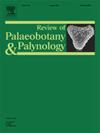Pollen atlas and morphological analysis of the selected types from southeastern Tibet, China
IF 1.7
3区 地球科学
Q2 PALEONTOLOGY
引用次数: 0
Abstract
The accuracy of fossil pollen identification is crucial for understanding past plant diversity, vegetation landscape and associated climate change, while dispersed/fossil pollen assignments heavily rely on how robust modern pollen reference is. There is high species richness in southeastern Tibet, China, however, pollen morphological studies in this area are still poorly documented. Here, we present pollen atlas of 57 species (40 genera, 22 families) collected from the Ranwu Lake Basin. Pollen grains were imaged with light microscope (LM, 100X oil-immersion objective lens) and scanning electron microscope (SEM). All pollen types are ordered and presented according to different aperture types and sculpture patterns, facilitating comparison with fossil pollen. Moreover, we selected some representative species mainly based on potential palaeoecological importance, including Sibiraea (Rosaceae), Koenigia cathayana (Polygonaceae), Stellera chamaejasme (Thymelaeaceae), Hordeum vulgare subsp. vulgare and Poa annua (Poaceae), to discuss their pollen identification characteristics for the first time and assess potential applications in Quaternary palaeoecological interpretation. This study enriches modern pollen atlas for Quaternary pollen analysis in the study area and the adjacent regions. Our results provide robust modern reference in pollen-based reconstruction of vegetation history, palaeoclimate and palaeoenvironment, and tracing pollen signal of local human activities as well.
中国西藏东南部部分类型的花粉图谱和形态分析
化石花粉鉴定的准确性对于了解过去的植物多样性、植被景观和相关气候变化至关重要,而分散/化石花粉的分配则在很大程度上依赖于现代花粉参考资料的可靠性。中国西藏东南部的物种丰富度很高,但这一地区的花粉形态学研究仍鲜有文献记载。在此,我们展示了从然乌湖盆地采集的 57 个物种(40 属 22 科)的花粉图谱。花粉粒用光学显微镜(LM,100 倍油浸物镜)和扫描电子显微镜(SEM)成像。所有花粉类型均按照不同的孔径类型和雕刻模式进行了排序和展示,以便于与化石花粉进行比较。此外,我们还根据潜在的古生态学重要性选择了一些具有代表性的物种,包括(蔷薇科)、(蓼科)、(百里香科)亚种和(蒲葵科),首次讨论了它们的花粉鉴定特征,并评估了它们在第四纪古生态学解释中的潜在应用。这项研究丰富了研究区及邻近地区第四纪花粉分析的现代花粉图谱。我们的研究结果为基于花粉重建植被历史、古气候和古环境,以及追踪当地人类活动的花粉信号提供了有力的现代参考。
本文章由计算机程序翻译,如有差异,请以英文原文为准。
求助全文
约1分钟内获得全文
求助全文
来源期刊
CiteScore
3.50
自引率
21.10%
发文量
149
审稿时长
6 months
期刊介绍:
The Review of Palaeobotany and Palynology is an international journal for articles in all fields of palaeobotany and palynology dealing with all groups, ranging from marine palynomorphs to higher land plants. Original contributions and comprehensive review papers should appeal to an international audience. Typical topics include but are not restricted to systematics, evolution, palaeobiology, palaeoecology, biostratigraphy, biochronology, palaeoclimatology, paleogeography, taphonomy, palaeoenvironmental reconstructions, vegetation history, and practical applications of palaeobotany and palynology, e.g. in coal and petroleum geology and archaeology. The journal especially encourages the publication of articles in which palaeobotany and palynology are applied for solving fundamental geological and biological problems as well as innovative and interdisciplinary approaches.

 求助内容:
求助内容: 应助结果提醒方式:
应助结果提醒方式:


